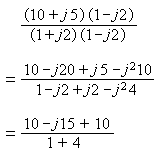
I am doing an Electrical Engineering course and would like to find out |
The imaginary part is a multiple of the number j:
![]()
The numbers 4 + j3, -1 + j5, -j3 are all examples of complex numbers.
Note that mathematicians sometimes use the symbol i for the square root of -1.
Engineers use i for other quantities (e.g. electric current) and j for complex numbers.
Separately add the real parts and the imaginary parts.
(4 - j3) + (-1 + j5) = 3 + j2. Because (real parts) 4 + (-1) = 3 and (imaginary parts) -j3 + j5 = j2.
Separately subtract the real parts and the imaginary parts.
(2 + j7) - (-1 + j3) = 3 + j4.
Multiply out the brackets term by term. Replace j2 with -1.
| (2 + j) × (-4 + j3) | |||||||
| = | 2 × -4 | + | 2 × j3 | + | j × -4 | + | j × j3 |
| = | -8 | + | j6 | + | -j4 | + | j23 |
| But j2 = -1 | |||||||
| = | -8 | + | j6 | - | j4 | + | -3 |
| = | -11 + j2 | ||||||
Multiply top and bottom of the division by the Conjugate of the bottom.
(The Conjugate of a complex number is what you get when you change the sign of the imaginary part.)
The conjugate of 1 + j2 is 1 - j2.

The bottom part always simplifies to a real number (in this case 5). So:

You can check that (4 - 3j)(1 + 2j) = 10 + 5j